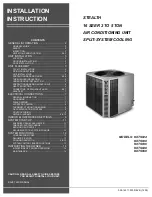
®
035-14511-000 REV B (1299)
8
Unitary Products Group
ACCESSORY WIRING
The electrical accessories available for this unit are a two
stage cooling thermostat and an optional De-humidification
Control. Refer to the individual instructions packaged with the
accessories for installation.
THERMOSTAT MOUNTING / WIRING
This condensing unit must be installed with the factory rec-
ommended thermostat, 2ET04700224 or any conventional
two-stage cooling thermostat. The difference between the
two stages of a typical two-stage thermostat is 2 - 2.5 °F.
The thermostat should be located about 5 ft. above the floor,
where it will be exposed to normal room air circulation. Do not
place it on an outside wall or where it is exposed to the radi-
ant effect from exposed glass or appliances, drafts from out-
side doors or supply air grilles.
After the thermostat is mounted, route the 24-volt control wir-
ing (NEC Class 2) from the thermostat to the indoor variable
speed air handler and outdoor unit. Route the control wiring
into the grommeted hole in the bottom of control box of the
outdoor unit. Using wire nuts connect to leads inside the low
voltage junction shown in Figure 6 and wiring diagrams
shown in Figures 7 -10.
Interconnecting control wiring must be a minimum of No. 18
AWG color coded insulated wires. If wire lengths increase
more than 90 feet, use No. 16 AWG wires, to prevent exces-
sive voltage drop.
NOTE: To eliminate erratic operation, seal the hole in the
wall at the thermostat with permagum or equivalent
to prevent air drafts affecting the anticipators in the
thermostat.
DE-HUMIDIFICATION CONTROL
A de-humidification control accessory 2HU06700124 may be
required in high humidity areas. This control provides cooling
at a reduced air flow, lowering evaporator temperature and
increasing latent capacity. To install, refer to instructions
packaged with the accessory and per Figure 7. Prior to the
installation of the de-humidistat control, the jumper across the
de-humidistat control terminals on the indoor variable speed
air handler/furnace terminal board must be removed.
During first or second stage cooling, if the relative humidity in
the space is higher than the desired set point of the de-humi-
distat control, the variable speed blower motor will operate at
a lower speed until the de-humidification control is satisfied.
A 40 - 60% relative humidity level is recommended to achieve
optimum comfort.
NOTE: If a de-humidification control is installed, it is recom-
mended that a minimum air flow of 325 cfm/ton be sup-
plied at all times.
FIELD CONNECTIONS - CONTROL WIRING
The recommended field connections for specific indoor air
handlers and furnaces are shown in Figures 7 through 10. All
connects to the outdoor unit are made in the low voltage junc-
tion box in the bottom left corner of the control box. Feed all
control wiring through the grommet in the bottom of the box.
Care should be taken so that all wire nut connections are firm
with no exposed wires that could short within the box. If the
fault line (X/L) is not connected to the thermostat, it should be
capped securely inside the box.
Variable Speed Air Handlers and Furnaces - connections
shown in Figure 7. The first stage thermostat signal is con-
nected to Y1 at the air handler/furnace control. It is critical the
Y2 OUT signal is connected to Y at the air handler/furnace
control to properly control the blower speed.
Single Speed Air Handlers and Furnaces - connections
shown in Figures 8 and 9. It is mandatory to connect the
appropriate blower relay to operate the low speeds. The first
stage thermostat signal is connected directly to Y1 on the
outdoor unit. Do not connect to Y at the indoor control. The
first stage blower operation is controlled by the G signal. It is
critical the Y2 OUT signal is connected to Y at the air handler/
furnace control to properly control the blower speed by
switching the relay to the high speed tap.
Two Stage Furnaces - connection shown in Figure 10. The
first stage thermostat signal is connected directly to Y1 on the
outdoor unit. Do not connect to Y at the indoor control. The
first stage blower operation is controlled by the G signal. It is
critical the Y2 OUT signal is connected to Y at the furnace
control to properly control the blower speed.
INDOOR BLOWER SPEED SETTINGS
Refer to the Tabular Data Sheet for the recommended air flow
settings for each size condensing unit.
Variable Speed Air Handlers and Furnaces - Set the high
speed cooling speed per the instructions for the air handler or
furnace by selecting the correct “cool” and “ADJ” taps. The
low speed setting will automatically be programmed for the
correct airflow. Verify the airflow by LED display on the speed
selection board.
Single Speed Air Handlers and Furnaces - It is mandatory a
fan relay kit be applied to the furnace or air handler. The air
handlers are designed to use the 2SF06700124 fan relay and
the furnaces should use a SPDT 24VAC Coil (15 AMP rating
@ 115V). See figures 8 and 9 for wiring connections. The
ideal fan setting is to set the high speed (second stage) air
flow at the fan motor high speed and the low speed (first-
stage) airflow at the fan low speed. If the low speed air flow is
too high, unsatisfactory dehumidifaction may occur on first
stage operation. To correct for unsatisfactory dehumidifica-
tion, add a dehumidistat per figures 8 or 9.
















